
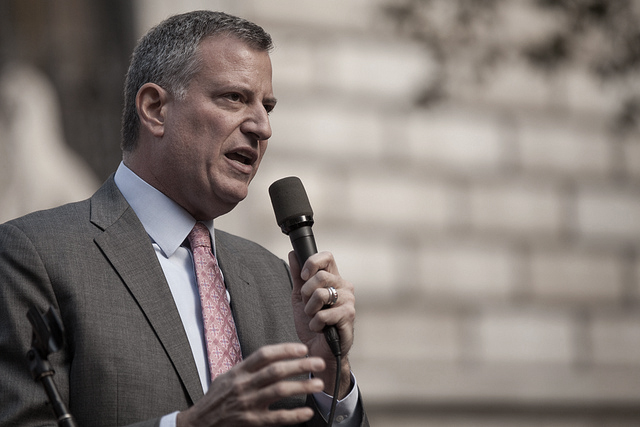 As City Hall attempts to jam thousands of more housing units concurrently with new commercial development near subway lines, it is presenting the Lefferts Gardens community with an ultimatum: Accept new development in the name of affordable housing so that other parts of the neighborhood will be shielded from rising real estate values, or be left at the mercy of market forces that have transformed other neighborhoods. (Photo: Kevin Case)
As City Hall attempts to jam thousands of more housing units concurrently with new commercial development near subway lines, it is presenting the Lefferts Gardens community with an ultimatum: Accept new development in the name of affordable housing so that other parts of the neighborhood will be shielded from rising real estate values, or be left at the mercy of market forces that have transformed other neighborhoods. (Photo: Kevin Case)
It’s no secret that real estate along beaches and park fronts is some of the most desirable land in the world. This is especially true for a gritty and gray city like New York, but few outside the mega-rich can afford to live alongside the periphery of the city’s lush parks. That’s what makes Prospect-Lefferts Gardens, a 45-square-block neighborhood in Brooklyn with a mostly African-American population, stand out.
While the average income of the neighborhood is below the city’s, the community sits at the southeast corner of Prospect Park, one of the borough’s most scenic outdoor areas, which has a large lake at its center, wide open grassy spaces and plenty of leafy corridors in which to get lost. On Sundays in the summertime, hundreds of people from the neighborhood – mostly of Afro-Caribbean descent – pack into the park, filling the air with the scent of chicken on the grill and the punchy percussion beats of goatskin drums. During autumn, people walk along the park’s edge while watching the yellowing leaves fall from the trees, and in the winter, you can even skate in the park’s new ice rink.
Once a drug-filled, crime-ridden area in the 1970s and 1980s, Prospect Park’s rehabilitation is said to be the reason for a sharp rise in interest and property prices in Lefferts Gardens.
The usual markers of gentrification have come to the neighborhood, including a quaint, hipster cafe and high-rise apartments.
The community is essentially a corner of East Flatbush, a larger neighborhood like many in Brooklyn, the Bronx and other poor urban areas around the country targeted by President Nixon’s assistant secretary of labor and low-key white supremacist, Daniel Moynihan, whose policy of “benign neglect” urged governments to let the ghettos burn and crumble so the people in them would flee the cities. New York City codified the philosophy in a strategy called “planned shrinkage,” inspired by the RAND Corporation’s call to eviscerate fire departments in low-income neighborhoods. Specifically, RAND pushed bogus fire alarm systems that garbled a caller’s connection to fire dispatchers, and also advocated for the systematic closing of fire departments in poor neighborhoods through a racist classification system. RAND would later sell the US Department of Housing and Urban Development on its ethnic rinsing program, which was also implemented in Washington, DC; St. Louis; Tampa and several major cities in the New York tri-state area.
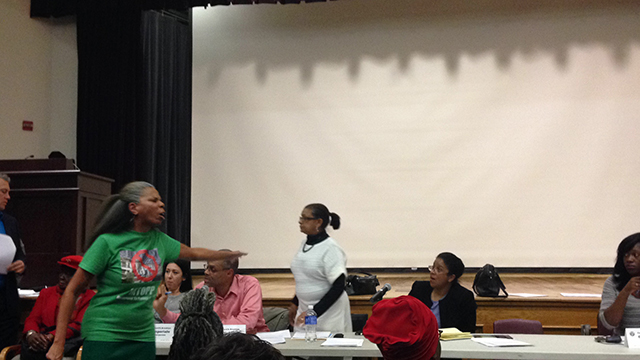 Alicia Boyd (left) chastises executive members of CB9, including District Manager Pearl Miles (center, in white) at a November meeting convened by community board 9 for cutting off time for public comments after 15 minutes. (Photo: Aaron Cantu)
Alicia Boyd (left) chastises executive members of CB9, including District Manager Pearl Miles (center, in white) at a November meeting convened by community board 9 for cutting off time for public comments after 15 minutes. (Photo: Aaron Cantu)
Firefighting resources flooded out of East Flatbush almost as critically as government investment in infrastructure, garbage disposal and schools stopped dribbling in. This was the prelude to the more familiar tale of rising murder and crime rates amid the crack epidemic that roiled the city in the 1980s. The Lefferts Gardens section of Flatbush was not as ravaged as other parts, partially thanks to a sizable multiracial middle class that developed in the midcentury – an anomaly in New York – but 10 years ago, residents say you could still see Bloods and Crips banging on certain street corners.
That has changed. The usual markers of gentrification have come to the neighborhood, including a quaint, hipster cafe and high-rise apartments. “The whites are moving back now,” said 95-year-old Innocita Bostick, a middle-class homeowner who bought a house in the neighborhood with her late husband in 1960. Back then they could do that on municipal worker salaries; today, her home is valued just under $1 million.
The gentrification of Lefferts Gardens is the backdrop of a contentious rift over the possible development of a wide commercial street in the neighborhood. A group called Movement to Protect the People, in alliance with other nearby anti-gentrification groups, launched a public campaign against this plan, as well as the local representatives championing it, alleging it will displace hundreds of thousands of poor residents of color.
The proposed changes are not coming at the behest of developers run amok, but from Democratic Mayor Bill de Blasio’s plan for affordable housing. As City Hall attempts to jam thousands of more housing units concurrently with new commercial development near subway lines, it is presenting the Lefferts Gardens community with an ultimatum: Accept new development in the name of affordable housing so that other parts of the neighborhood will be shielded from rising real estate values, or be left at the mercy of market forces that have transformed other neighborhoods. Either way, displacement and change seem all but guaranteed, slicing local opposition to gentrification into two camps: those who want to accept the mayor’s compromise, and those who want to reject it outright.
The New Central Park
 A view of Prospect Park in October near the Lefferts Gardens edge. (Photo: Aaron Cantu)
A view of Prospect Park in October near the Lefferts Gardens edge. (Photo: Aaron Cantu)
Peering upward at the 23 stories of concrete and steel frames, you could be forgiven for believing you had transported from deep Brooklyn to midtown Manhattan. But 626 Flatbush, a high-rise residential tower under construction since mid-2014, sits at the edge of Prospect Park, towering over the boxy apartments and medieval-style row homes that rise no higher than four stories.
626 Flatbush is only one of about a dozen luxury buildings under construction in the neighborhood, but it is the tallest, and, residents say, the gaudiest. Developers usually prefer to build short and wide buildings because the costs are lower than for tall buildings, which entail higher insurance rates and have less livable space because of added utilities associated with their height (like elevators). But 626 Flatbush’s proximity to the park flipped that equation on its head; with 10 stories of park views, developer Hudson Companies will be able to charge high enough rents to justify the height.
“They’re making [Prospect Park] the new Central Park,” said Jesse Hamilton, a former district leader for the nearby Crown Heights neighborhood (and current state senator), last July in a recorded conversation with activists. “You don’t want things blocking your view here. The views of the park are breathtaking.”
“While [Lefferts Gardens] has always been mixed-income, the addition of the tower would change the rental market so that long-time residents living on fixed incomes would not be able to afford to stay.”
The zoning parameters of Lefferts Gardens were last revised in 1961, before fly-by-night high-rise condos transformed so much of the borough’s skyline. Nothing in those laws mandated Hudson Companies to first relay its building plans to the community, which was blindsided by the development. In December 2013, soon after learning of the construction plans, local groups filed a lawsuit against Hudson Companies as well as the New York State Housing Finance Agency, which subsidized the project with a $72 million loan. They charged that the tower was approved without a proper study by the Housing Finance Agency to determine how it would impact the neighborhood.
“While [Lefferts Gardens] has always been mixed-income, the addition of the tower would change the rental market so that long-time residents living on fixed incomes would not be able to afford to stay,” charged Legal Services NYC, the group representing the community. Realizing the city and state had already allocated funds for the building’s construction, the lawsuit demanded only that the city force Hudson Companies to scale the building down to nine stories and expand its number of affordable units (the original plan was that 80 percent of units would be rented at market rates, while 20 percent would be rented to those making no more than 50 percent of the neighborhood’s median income of $39,319).
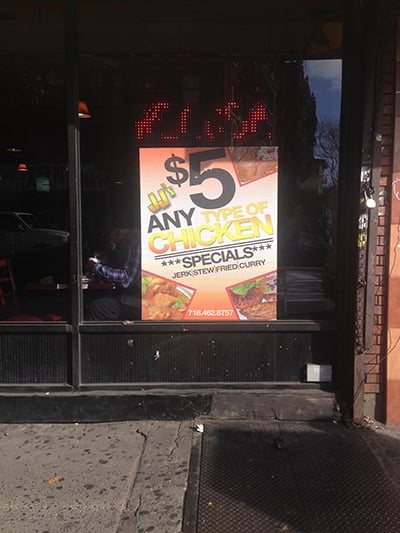 A Jamaican restaurant on Flatbush Avenue offers an entire chicken dinner for $5. (Photo: Aaron Cantu)Although a judge ordered Hudson Companies to halt construction of the tower in late May 2014 so the Housing Finance Agency could review its impact, construction resumed a month and a half later, after the agency convinced the same judge that the environmental consequences of the project were “slight.”
A Jamaican restaurant on Flatbush Avenue offers an entire chicken dinner for $5. (Photo: Aaron Cantu)Although a judge ordered Hudson Companies to halt construction of the tower in late May 2014 so the Housing Finance Agency could review its impact, construction resumed a month and a half later, after the agency convinced the same judge that the environmental consequences of the project were “slight.”
The gentrifying effects of 626 Flatbush are clear enough. If 80 percent of the building’s 254 units are rented for approximately $1,620 per month each, that means wealthier residents will join those who’ve already flocked to Lefferts Gardens during the last 18 months of “astronomical interest,” said Matt Pucker of Douglas Elliman, a real estate company that brokers for clients in the neighborhood.
“We have seen a tremendous amount of interest,” Pucker told Truthout. “As soon as [properties] were available, they came off the market, and there are many more interested people that we haven’t been able to fill their need.”
It is Pucker’s job to hype neighborhoods in which his company deals, but he emphasized that Prospect Park was a major selling point for newcomers priced out of Manhattan and hip areas of Brooklyn. “They want to be in a desirable neighborhood along the park,” he said. “That’s not changing.”
626 Flatbush galvanized the community, and even though it was unable to prevent the tower’s construction, residents mobilized to demand the Department of City Planning shield Lefferts Gardens from similar projects in the future. But the city will only grant these protections if the local community board allows the mayor to pursue his own brand of development in the neighborhood.
The Ghost of Bloomberg
In his State of the City speech on February 3, Mayor Bill de Blasio reiterated his dual support for affordable housing and new real estate development.
“We want to work with the real estate industry to build. We must build more to achieve our vision.”
His administration will “require developers to build affordable homes for everyday people rather than simply multimillion-dollar condos for the most fortunate among us,” the mayor said. But, he added, “We want to work with the real estate industry to build. We must build more to achieve our vision.”
In terms of physical space, there are already many more homes than people who need homes in New York City, and housing advocates have questioned why the need for low-cost housing should necessitate more construction. But much of de Blasio’s far-reaching plan to entice developers to build 80,000 new units of affordable housing rests on an urban framework called “transit-oriented development” (TOD), which consists of dense networks of “mixed-use, mixed-income centers linked by the region’s extensive commuter rail network,” according to a report by the US Department of Housing and Urban Development.
 A newly opened bar on Flatbush Avenue bar offers craft beer starting at $6. (Photo: Aaron Cantu)To understand the inspiration for TOD in the current mayor’s plan, however, you need to reach back further, to an initiative by former Mayor Michael Bloomberg called PlaNYC2030.
A newly opened bar on Flatbush Avenue bar offers craft beer starting at $6. (Photo: Aaron Cantu)To understand the inspiration for TOD in the current mayor’s plan, however, you need to reach back further, to an initiative by former Mayor Michael Bloomberg called PlaNYC2030.
At its core, PlaNYC was a blueprint to house a theoretical million more New Yorkers by 2030 in an environmentally sustainable way by clustering new, greener residential and commercial buildings along transit lines to reduce vehicular carbon emissions – in other words, through transit-oriented development. Under the 1961 zoning parameters, the city could not legally pursue TOD in many of the places it wanted to because it was hindered by limits to density and commercial building construction. So beginning under Bloomberg, the city’s response has been to rezone these areas, particularly through “upzoning,” which allows for denser commercial development (conversely, “downzoning” means limiting such development).
PlaNYC didn’t just expect a million new New Yorkers by 2030; it made their immigration to New York a first priority. Although PlaNYC said this influx was necessary to ensure the city reduced its annual greenhouse gas emissions by 49.2 million metric tons every year (so long as the new arrivals lived in new, denser communities around transit lines), another follow-up report in 2010 said that rezoning for new development was the centerpiece of a “pro-growth agenda” that included “bold redevelopment plans and major rezonings designed to create jobs and increase the City’s tax base.”
It’s difficult to say how much the vision of a million more New Yorkers is a self-fulfilling prophecy. PlaNYC was drafted, after all, by a business consultant for a business-minded, billionaire mayor whose first focus for the city was more tax revenue (despite his purported environmental concern, Bloomberg invests significantly in oil and gas assets). But the “million more” assumption has been taken as good as fact, since it is now embedded in de Blasio’s vision to build and preserve 80,000 and 120,000 units, respectively, of affordable housing over the next nine years. And as Gothamist reported, that plan is slated to create only 16,000 affordable homes for 980,000 households that earn below $42,000 a year – or less than 3 percent of what is needed.
East New York: Canary in the Affordable Housing Coal Mine
East New York, a low-income neighborhood at the far east end of Brooklyn, has a slightly different history and character than Lefferts Gardens, but both were affected by the same historical processes and are now targets for the mayor’s TOD-laced affordable housing plan.
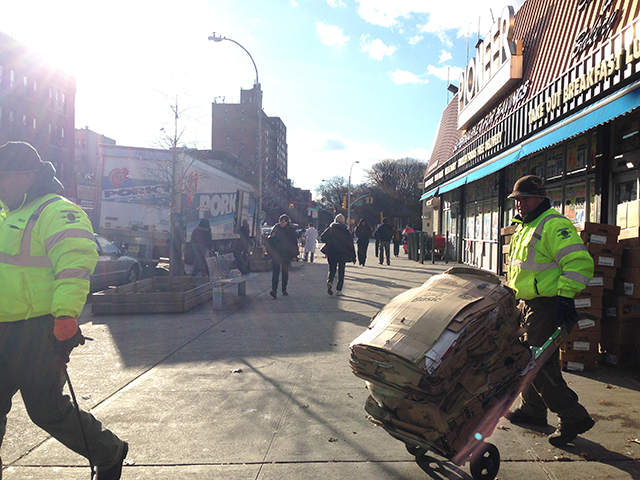 Workers haul recyclables a block from Prospect Park, near the Parkside subway stop. (Photo: Aaron Cantu)
Workers haul recyclables a block from Prospect Park, near the Parkside subway stop. (Photo: Aaron Cantu)
Once a manufacturing center in the early 20th century, by the 1960s, real estate agents used the influx of Puerto Ricans, Caribbeans and African-Americans in East New York to incite white flight and then sell homes at a serious markup to people of color. The subsequent policy of planned shrinkage eviscerated firefighting resources and strangled public investment, leaving East New York a hollow, urban sump where crime festered during the crack years. The city made some efforts in later years to create low-cost homes for the poor, but it has remained mostly dilapidated, making it a perfect test case for the mayor.
If 626 Flatbush represented the old way a neighborhood gentrified, East New York’s still unfolding affordable housing odyssey represents the new way.
Median income in East New York is $34,000, which is just below Lefferts Gardens’ median, and roughly $10,000 less than Brooklyn’s overall median income. Yet, of the 200,000 affordable housing units de Blasio plans to build or refurbish across the city, an estimated 138,000 will go to renters whose annual salary is between $41,951 and $100,680 and who can be expected to pay anywhere from $1,000 to $3,500 a month on rent. And in neighborhoods like East New York, where the city is incentivizing developers with tax credits and extended height limits for new buildings, real estate speculators may be pushing those units even further out of reach for the poor. The prospect of investment from the city in places where it intends to build affordable housing also has the inadvertent effect of raising land and housing prices. “The more that wave swells, the more expensive it will be to build,” writes Andrew Rice in New York magazine, “and the more elastic the term ‘affordable’ may have to become to meet de Blasio’s goals.” If 626 Flatbush represented the old way a neighborhood gentrified, East New York’s still unfolding affordable housing odyssey represents the new way.
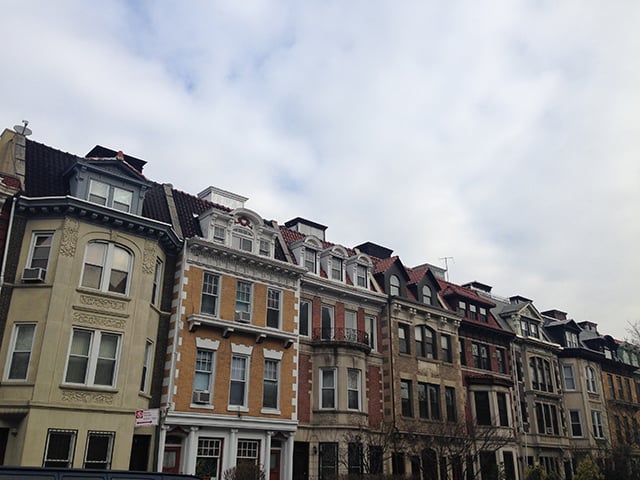
“The bottom line is this: The city has to rezone in order to create these new development opportunities for a million new people,” Tom Angotti, director of the Hunter College Center for Community Planning and Development, told Truthout. In a piece for Jacobin, Angotti said that de Blasio’s affordable housing plan “deals with housing as if it existed in a free market – as if it were just a matter of individual apartments combined. But it exists in a land market, where values are determined largely by location and zoning capacity. In areas with high land values, the new inclusionary development will just feed the fire of gentrification.”
That’s also the warning offered by the US Department of Housing and Urban Development on different variants of TOD being pursued in the South Bronx, Long Island, and several cities in Connecticut and New York State. Such development, HUD said in a report, “has the potential to spur gentrification” because new residential developments with wealthier occupants can raise overall property prices. That appears to be what is happening in East New York, where The Wall Street Journal found last September that land prices had almost tripled in one year.
In Lefferts Gardens, the local community board wants to allow the Department of City Planning to study a wide thoroughfare for upzoning. Many view it as an omen for gentrification to come; upzoning would open the street for the sort of dense residential-commercial development the city is pursuing in East New York. Yet there are others who believe the community must allow the study and permit some transit-oriented development so that the city will protect the rest of the community from egregious projects like 626 Flatbush. The division captures the increasing complexity of gentrification resistance campaigns in the era of de Blasio’s affordable housing boom.
The Fight for Empire Boulevard
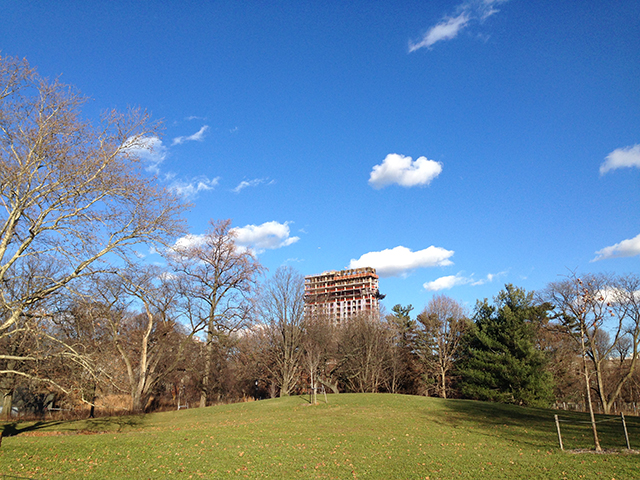 A view of 626 Flatbush from Prospect Park. (Photo: Aaron Cantu)
A view of 626 Flatbush from Prospect Park. (Photo: Aaron Cantu)
In March 2014, Community Board 9 (CB9), the representative body of Lefferts Gardens as well as some surrounding neighborhoods, held a town hall meeting to take public comments about a study to rezone certain parts of the community. Spurned by 626 Flatbush, many wanted to downzone the neighborhood in order to prevent similar high rises in the future.
“The tower thing drove everyone crazy,” Tim Thomas, a member of CB9, told Truthout. “So some of us said, ‘We gotta rezone, or this is going to keep happening.'”
The town hall was convened so the community could convey what they wanted out of the proposed rezoning study. Residents voiced deep opposition to unfettered development and demanded large parts of the neighborhood be downzoned, noting that white middle-class neighborhoods around Prospect Park had been downzoned in recent years.
“We are the densest populated area in Brooklyn and the second most affordable. We don’t need or want more people. We don’t need the creation of affordable housing.”
CB9 had assured attendees their input would be included in a resolution to study the neighborhood for rezoning. CB9’s district manager, Pearl Miles, drafted the resolution and the board approved it. But after the resolution was made public, community members said its technical language did not echo what had been demanded at the town hall. In particular, the resolution requests that City Planning study the possibility of upzoning a wide thoroughfare near transit lines called Empire Boulevard in order to “increase residential and retail density along transit and commercial corridors.” That language mirrored the city’s plan to create higher density, “mixed-use growth with housing and retail along transit corridors” in East New York, and some wondered how much City Planning had a hand in drafting the resolution.
Many in the community were incensed, believing it had been approved in the face of blatant public opposition, but Tim Thomas claimed the decision was pragmatic.
“The board believed the rezoning plan hit all the important points and we voted on it, but some people said it should have gone to the community [vote] first,” Thomas told Truthout. He explained that members of CB9 believed allowing City Planning to upzone Empire Boulevard would guarantee protection for other areas of the neighborhood through contextual zoning (which would mandate that new development cohere to the architectural “character” of the neighborhood) as well as downzoning.
“They’re not going to [downzone or contextually zone] if they can’t get some new units out of it,” he said. “So the obvious place to do that is along Empire Boulevard.”
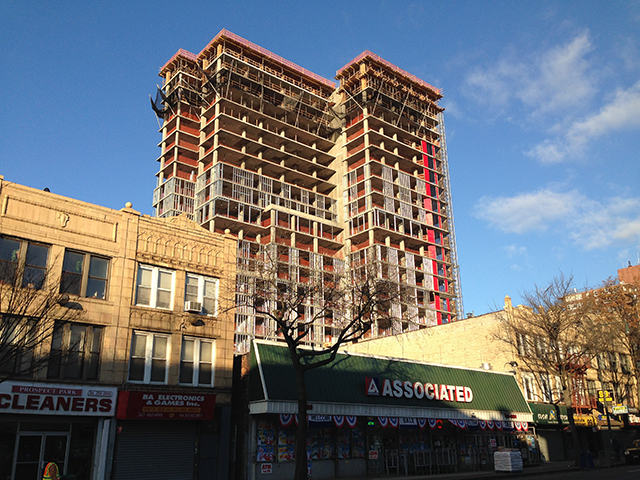 A view of 626 Flatbush from the street. (Photo: Aaron Cantu)
A view of 626 Flatbush from the street. (Photo: Aaron Cantu)
A representative of City Planning indicated that their office prioritizes rezoning proposals that facilitate the mayor’s TOD affordable housing plan.
“At this point, [Department of City Planning] staff resources are prioritized to areas that can fulfill the Mayor’s mandate to address the affordable housing crisis as well as to make the city more equitable, resilient and foster economic opportunity,” the representative wrote in an email to Truthout.
Alicia Boyd, founder of the anti-gentrification group Movement to Protect the People (MTOPP), called attention to the fact that other neighborhoods near Prospect Park – including Boerum Hill and Carroll Gardens – were downzoned without having to offer up parcels of land for transit-oriented development. The ultimatum given to Lefferts Gardens – that it can only downzone some areas if Empire Boulevard is upzoned – is racially motivated, Boyd claims: Lefferts Gardens is one of only two neighborhoods near Prospect Park that is majority non-white. The other – Park Slope along 4th Avenue – has not been downzoned and has been the site of a serious real estate boom in the last year.
“We are the densest populated area in Brooklyn and the second most affordable,” Boyd said in an email. “We don’t need or want more people. We don’t need the creation of affordable housing.”
Boyd also alleged, contrary to assurances from CB9, that upzoning Empire Boulevard would mean paving the way for high-rise residential towers along the thoroughfare – a claim that Thomas dismissed, but which was partially corroborated by State Senator Jesse Hamilton.
“From a practical building perspective, if you want affordable [housing], you can’t go six stories,” Hamilton told MTOPP last summer. He estimated the buildings would have to be at least 20 stories to guarantee developers’ a profit.
Fear of high rises on Empire Boulevard and deep resentment over CB9’s resolution led to months of open protests by MTOPP. Tensions reached a high point in September 2014, when several anti-gentrification activists, clad in green shirts, showed up to the monthly community board meeting to demand CB9 rescind its vote for the rezoning study. Their loud showing seemed to pay off when the community board re-voted and successfully overturned the resolution, but that vote was later nullified by Miles, the CB9 district manager and resolution author, who said the number of “yes” votes for the study outnumbered the number of “no’s” plus abstentions, meaning the upzoning study would go forward as planned.
That seemed to be the nail in the coffin for MTOPP and others hoping to scuttle the resolution. But in November, Miles stunned the community when she revealed at the monthly CB9 meeting that she had miscounted those votes, and that there had been more “yes” votes than “no’s” and abstentions – Miles had incorrectly counted two “yes” votes as abstentions. The discrepancy was exposed after MTOPP filed a Freedom of Information Act request for Miles’ handwritten count of the vote in September and cross-referenced it with video footage of the meeting.
Miles said she had miscounted because of the noisiness of the September meeting, and a new vote on the resolution is scheduled for early February. MTOPP is currently suing Miles and the entire CB9 executive board for their immediate removal, charging, among other things, violations to parliamentary procedures that it claims limited public input. They’re also asking that Hunter College study a rezoning plan for Empire Boulevard instead of City Planning, which Boyd claimed was “perfectly legal.”
City Planning Drives the Machine
Though the resolution was officially rescinded, members of CB9’s executive board are planning to reintroduce the rezoning study to the community at an upcoming meeting, according to Thomas. In early January, all 33 members of CB9 attended an “education and training” meeting with City Planning.
“The purpose of the planned training session with members of Community Board 9 is to provide education and training for these members about zoning and the Uniform Land Use Review Procedure (ULURP), in general,” wrote City Planning’s Winston Von Engel in an email to Alicia Boyd that was obtained by Truthout.
Boyd said that City Planning tried convincing CB9 members that after the upzoning study of Empire Boulevard was complete, the public would have the chance to voice concerns about its recommendations. But it is unlikely that such input would be seriously considered by the city, especially if it were contrary to the upzoning plan, Tom Angotti told Truthout. He predicted that after the study, City Planning officials will use a series of compelling arguments to convince the community why it should get on board with upzoning Empire Boulevard. “They’ll tell everybody that it’s a concession that will have to be made in order to protect the rest of the neighborhood [from gentrification],” he said, adding, “Once the machine starts to run, it’s really hard to stop. City Planning drives the machine, and once they do a study, they have a framework they follow, a formula.” That formula, he said, includes “upzoning wide avenues for development, and rezoning side streets with contextual zoning that limits the amount of new development.” In plain English, that means the same transit-oriented development that is central to the mayor’s affordable housing plan.
“It’s Happening to Everyone”
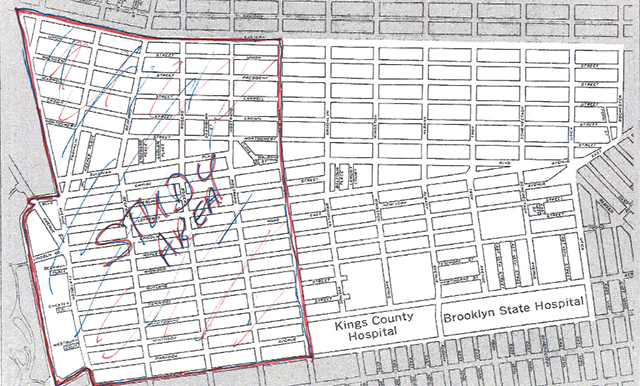 The area that will potentially be studied for rezoning. (Photo: Aaron Cantu)
The area that will potentially be studied for rezoning. (Photo: Aaron Cantu)
On a cold, clear day in January, the grass on the Lefferts Gardens edge of Prospect Park appears as green as it did in the summertime, and the pond waves shimmer brilliantly as a raft of ducks cuts against the current. The bare tree branches gnarled toward the sky are the only indication of a change of season. But many of the people who lived around the park six months earlier are no longer there, including Tamaya French,* who was forced from her apartment a few days after Thanksgiving.
French, a home care worker, Haitian immigrant and single mother, said she makes around $15,000 a year, meaning she and her son make up one of the 980,000 households for which de Blasio’s housing plan will only create 16,000 units of affordable housing.
Displacement “sometimes used to happen to people here, but now it’s happening to everyone here. Everywhere.”
“Now things are not as easy as before,” French said, acknowledging her finances have been stretched severely since her son Joseph was born six years ago. “I have more expenses. Everything is not that easy; you have to pay this and that; the money is not enough for me.” She worried about where Joseph would go to school after the two of them moved in with French’s sister – and she worried how long her sister would tolerate their presence. She complained about leaving behind years of accumulated possessions because she could not afford to move them. But, she added morosely, at least she’s not alone; displacement “sometimes used to happen to people here, but now it’s happening to everyone here. Everywhere.”
She’s right. The average rent for an apartment in Lefferts Garden increased 7.2 percent from 2013 to 2014, the second highest increase of all Brooklyn’s neighborhoods. And Brooklyn itself was found by a widely covered study to be the least affordable place to live in the United States, in terms of median income compared to home prices.
Imani Henry, an organizer with the anti-gentrification group Equality for Flatbush, said the displacement that French and thousands of others are experiencing is akin to a contemporary “trail of tears.”
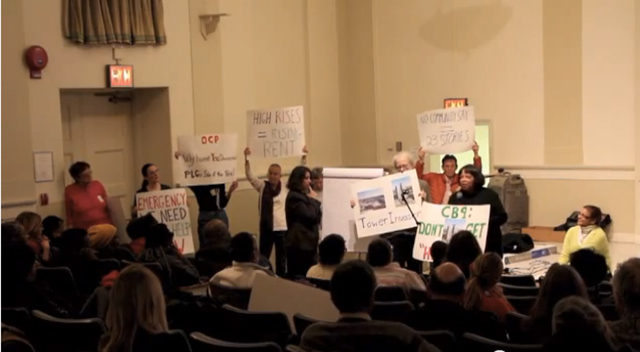 Residents at the CB9 townhall meeting in March 2014. (Photo: Aaron Cantu)
Residents at the CB9 townhall meeting in March 2014. (Photo: Aaron Cantu)
“We are literally moving longtime Brooklyn residents to Ithaca,” Henry told Truthout. “I know for a fact there are folks who’ve retired and have to move to Staten Island where they know no one.” Of those who own their homes rather than rent, Henry said homeowners are harassed by prospectors interested in buying their property “everyday.”
In response to rampant displacement, anti-gentrification groups are increasingly coordinating their struggles, progressive mayor be damned. Henry’s Equality for Flatbush has worked closely with Alicia Boyd’s MTOPP, and the two are connecting with other similar groups in Brooklyn as well as the general public for a project called Before It’s Gone // Take It Back. An initiative by Equality for Flatbush, the project will allow everyday people to respond to the crisis of gentrification of Brooklyn, NY.”
A Breaking Point
 A flier for a community speakout against 626 Flatbush. (Photo: Aaron Cantu)Gentrification resulting from de Blasio’s affordable housing boom will not unfold the same way it did over the last decade in Brooklyn neighborhoods like Williamsburg and Bushwick. The displacement and replacement will be less absolute, with some long-term residents benefitting from new affordable housing units. But rising land and home prices buoyed by the city’s investment will ensure that the basic pattern looks the same.
A flier for a community speakout against 626 Flatbush. (Photo: Aaron Cantu)Gentrification resulting from de Blasio’s affordable housing boom will not unfold the same way it did over the last decade in Brooklyn neighborhoods like Williamsburg and Bushwick. The displacement and replacement will be less absolute, with some long-term residents benefitting from new affordable housing units. But rising land and home prices buoyed by the city’s investment will ensure that the basic pattern looks the same.
As gentrification in New York comes increasingly under the guise of affordable housing, the battle lines are also becoming less pronounced, and anti-gentrification advocates don’t always find themselves issuing the same calls to action. Tim Thomas and Alicia Boyd both say they oppose gentrification, but find themselves on opposite sides of CB9’s resolution battle. Boyd opposes the affordable housing compromise, and wants the city to downzone Lefferts Gardens unconditionally; Thomas endorses the compromise, and believes fighting against gentrification should take place on other fronts.
“Gentrification has a lot more to do with rent-stabilized buildings and racist landlords breaking the law than it has to do with building new buildings,” Thomas told Truthout. Nevertheless, he wondered how long the pattern could continue without a serious rupture. “It feels like there’s a breaking point. A point where people are not going to take it anymore may be fast approaching.”
Boyd seemed to agree.
“These are our lives, our community and our people that we are fighting for – and we will fight with everything we got,” she said.
*Name has been changed.
5 Days Left: All gifts to Truthout now matched!
From now until the end of the year, all donations to Truthout will be matched dollar for dollar up to $50,000! Thanks to a generous supporter, your one-time gift today will be matched immediately. As well, your monthly donation will be matched for the whole first year, doubling your impact.
We have just 5 days left to raise $50,000 and receive the full match.
This matching gift comes at a critical time. As Trump attempts to silence dissenting voices and oppositional nonprofits, reader support is our best defense against the right-wing agenda.
Help Truthout confront Trump’s fascism in 2026, and have your donation matched now!